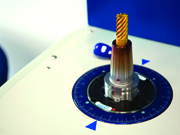by Drew Strauchen
4 ways proper tooling balance saves time and eliminates problems
Balance is as critical as tool presetting and tool path generation. Improperly applied, all can have disastrous consequences on the manufacturing process.
The conversation about optimizing machining processes typically revolves around the CAM software, control, machine tool, tooling and fixturing. When tooling is reviewed, all too often balance is ignored or given mere lip service before quickly shifting gears to other topics.
“Balance doesn’t matter that much” or “my toolholders come balanced” are common phrases expressed during the discussion of balance. The truth is, balance does matter and it has a potentially huge impact on every operation (slow or fast), and holders balanced naked (without assembled components like collets, nuts, retention knobs) have no real balance to them once put in the machine fully assembled.
Want to improve productivity, increase tool life, reduce machine downtime and ensure accuracy? Take another look at balance, and you may begin saying what so many others are starting to say, which is “how did I ever do this before I started balancing?”
TOOL LIFE
Unbalanced toolholder assemblies create centrifugal forces that cause excessive vibration and chatter. This vibration leads to faster chipping and/or wear to cutting tools and inserts.
Independent studies have proven that tool assemblies (all components like collets, nuts, tool and retention knob included) that are balanced yield 20 per cent more tool life than the same unbalanced toolholder assemblies.
 If you want to maximize the life of your cutting tools and indexable tools, balance everything before you start machining.
If you want to maximize the life of your cutting tools and indexable tools, balance everything before you start machining.
FASTER MACHINING SPEEDS
The vast majority of machines and cutting tools are not being utilized to their fullest potential.
Maximum speeds and depths of cut are typically learned through trial and error, with tool wear and/or audible sound (vibration) being the tangible cues as to when a tool has reached its limit.
Unbalanced tool assemblies generate more vibration and premature tool wear, thereby leading operators to run at slower speeds than they otherwise could if the assemblies were all properly balanced.
Try balancing tool assemblies and reevaluating the speeds from there. On average, speeds can be increased 15-25 per cent after balancing with no signs of additional wear or chatter.
MACHINE SPINDLE LIFE
Think a balancing machine is expensive? It is nothing when compared to the cost of replacing a spindle or the even greater cost of machine downtime.
The centrifugal forces created by improperly balanced toolholder assemblies have an incredible negative impact on the machine spindle bearings. Spindles that should last 10 years are often burned up in less than a year in these cases.
This is why most machine tool manufacturers will not warranty their spindles if unbalanced tooling is used, and demand balance of G2.5 at maximum spindle speed of the machine.
IMPROVED ACCURACY
Did you know that a tool measured with perfect static (not rotating) runout can see as much as 12 microns runout when actually running at higher speeds?
This is because centrifugal forces created by unbalance can create dynamic runout where none was measured statically.
To ensure precision, make sure to balance your complete toolholder assembly (all components assembled) before machining. This will help ensure accuracy, while also improving surface finish via the reduction in vibration. SMT
Drew Strauchen, vice president, marketing and business development North America, Haimer USA.
